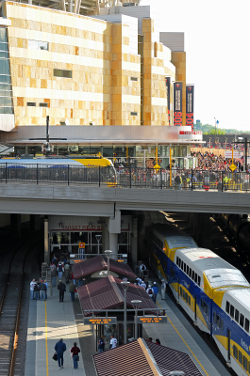Rail transit
Commuter rail
Commuter rail is a passenger train service that connects an urban region together over moderate distances; which typically operates on existing freight tracks; and whose primary clientele travels between home and work. These trip-to-work services usually offer concentrated frequencies primarily during rush hour, with suburban station spacing typically every five miles. Commuter rail service may be either locomotive-hauled or self-propelled, and is characterized by reduced fair multitrip tickets, specific station-to-station fares, and usually only one or two stations in the central business district. Average speeds are 18 to 55 mph. The Northstar rail line from Big Lake to Minneapolis is the first example of commuter rail in Minnesota. The Northstar Expansion proposes to extend service to St. Cloud.
Light rail transit
Light Rail Transit is an electrically powered, two-rail technology capable of providing a broad range of passenger capacities, and operating as single vehicles or in short trains on a variety of alignment types. It is a mode combining vehicle technology very similar to that of streetcars, but operating primarily on a partially controlled right-of-way and typically at higher speeds and passenger loadings. LRT typically operates with frequent stops spaced one-half-mile to one-mile apart in dense urban environments at speeds of 20 to 50 mph. The Hiawatha line from the Minneapolis/St. Paul Airport to downtown Minneapolis is an example of LRT, as will be the proposed Central Corridor line along University Avenue connecting St. Paul and Minneapolis.

 Commuter Rail Safety
Commuter Rail Safety